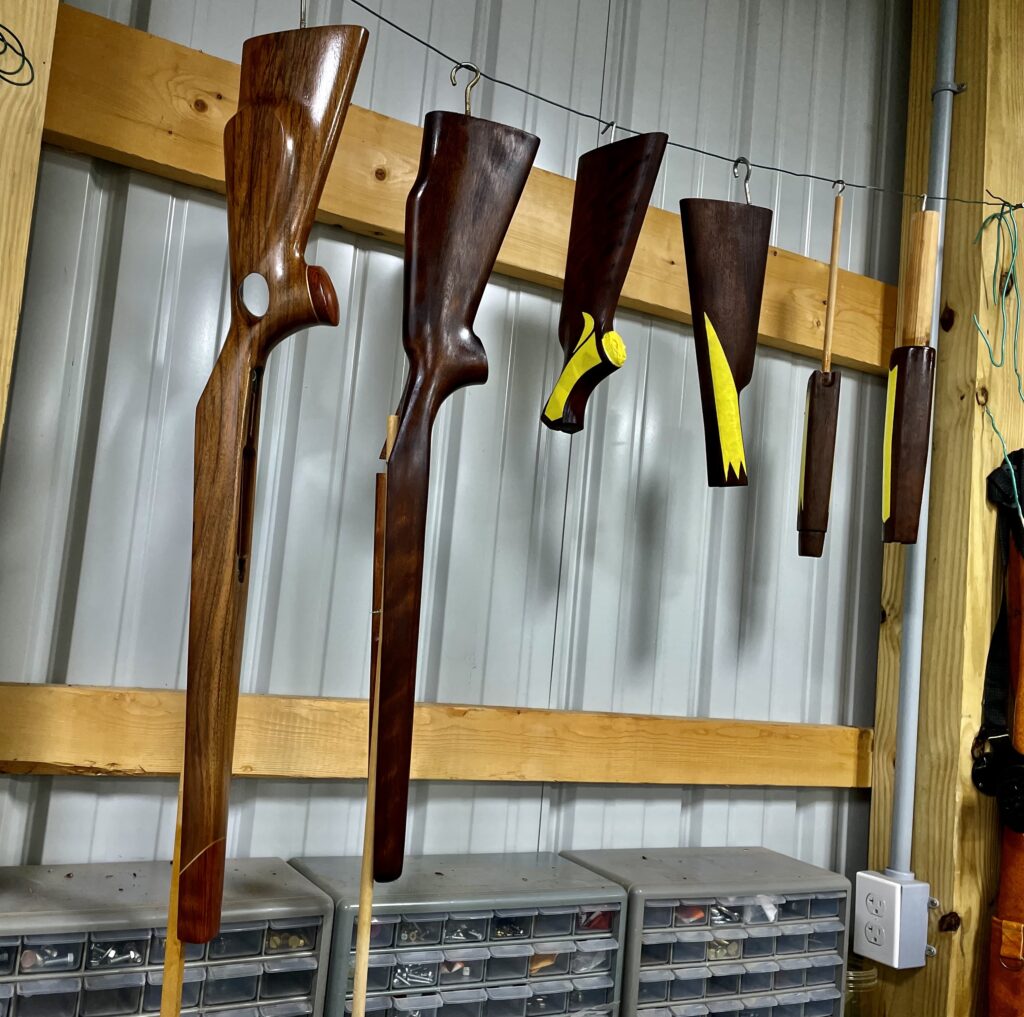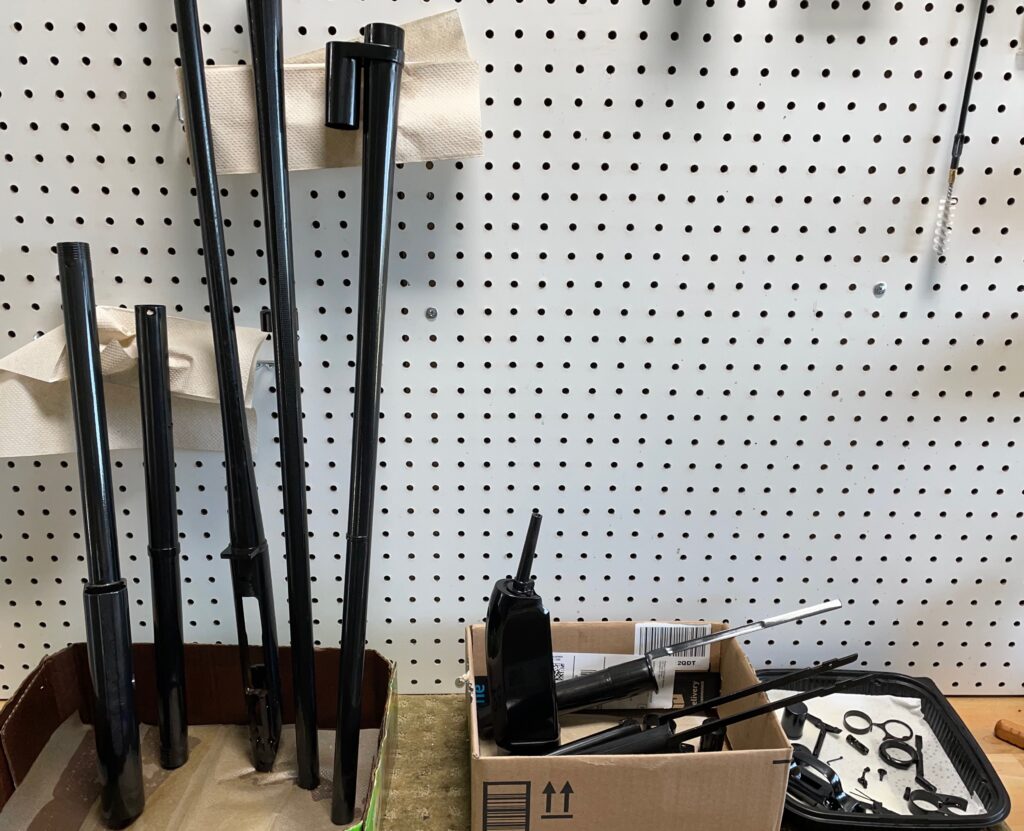Sometimes your firearms need a facelift!
Not all firearm repairs that come into the shop are for mechanical failures. I have many clients who bring in firearms that have been, let’s say, Well Loved. Many guns have seen long and hard usage in the field, sometimes over several generation. Stock finishes wear through, bluing can worn off, rust attacks metal parts over the course of a firearm’s working life. Accidents afield can result in broken stocks, dented barrels and other forms of damage. Most of the time, giving a gun a make-over can extend its life for a few more generations and improve its aesthetic appeal.

Most stock work is not a fast process! The type of damage and type of wood play a big role on how many processes have to be performed to bring the stock back to a finished state. Much of the stock wood from lower priced modes and brands is made from beech or birch and occasionally maple. These are very light colored woods and typically were dipped in a type of gel stain finish to get an even brown coloration…these finishes are generally not durable and a chip or scratch is very obvious. Even walnut can be challenging, as stock blanks can be cut containing different amounts of sapwood and heartwood and two-piece stocks will often have very different color woods. Achieving a balanced and pleasing color and tone on these stocks and applying a durable finish takes several days…very different from the single dip and into the drying oven approach that a manufacturing facility would use.
Refinishing the metal parts of a firearm is a lot more involved than what most folks would expect. When I worked on old guns in my youth, using wipe on cold blue solutions was the norm. I learned very quickly that to be done well, you need to follow the same preparation processes that standard hot caustic or slow bluing requires: Eliminate all old bluing, eliminate all rust, polish out all pits and scratches, polish to a even finish and degrease, degrease and degrease some more. One needs to manage expectations when having firearms refinished…not getting a silk purse from a sows ear is a reality. Heavy barrel pitting or receiver pitting cannot always be filed, ground or polished out completely and subsurface rust can/will resurface. Metallurgy also plays a role. Some of the alloys used in casting receivers, trigger guards, sights, etc. can be more porous and very different from barrel or magazine tube steels…and then there are aluminum components which are a completely different matter! Manufactures have the luxury have having several alternate metal finishing processes available to them. This is rarely the case for a gunsmith shop, however there are some gunsmiths who specialize in these services. I can facilitate having finishing of components done by these specialists, as well as having Cerakote finishes applied.

Hot caustic bluing is by far the most common type of “bluing” process used on the steel components of firearms used by manufacturers and gunsmiths alike. I utilize the same bluing process and chemicals that manufacturers such as Remington, Winchester, Marlin etc. have been using for decades. It requires special equipment, nasty chemicals and does produce a factory fresh finish. Something that I researched and learned about 30 years ago was a more historical approach to blued finishes: slow rust bluing. This approach was used by fine custom riflesmiths and is basically the required approach on fine double guns whose barrels are soft soldered together…dropping these into hot caustic bluing tanks would be catastrophic! This approach to bluing actually goes back to the 18th century and was used by noted rifle maker A.O Niedner back in the 1920s-1940. The finish is different, as the process actually causes a metallurgical change at the molecular level. The finish develops through the metal’s surface giving that deep almost translucent appearance seen of fine shotguns and rifles from the past century. I use this approach on any double gun refinishing and on some older classic firearms.
Other types of services include, installing sling swivels, recoil pads/butt plates, action bedding, refreshing checkering (some firearms have stamped or pressed checkering patterns that can be converted to cut checkering…but its an onerous task!) and making adjustments for fit and length of pull. Not much can be done with plastic stocks when they break…and the do break! A growing trend I’ve seen is restocking of plastic stocked rifles with wood and laminate stocks. There are several after-market stock manufacturers that can provide excellent replacement stocks that can increase the shooter’s enjoyment as well as appearance. I can say I’m often amazed when people come in to the shop with their hollow plastic-stocked magnum rifle and tell me they can’t stand to shoot it…I wouldn’t want to either. But change that out for a well fitted and bedded laminated hardwood stock and that gun becomes their favorite for the range and field. If this is something you are interested in, drop me a line. I have a dealer account with Boyd’s Hardwoods, whose product and selections are excellent and would be happy to help you with that.
If you are thinking about having your old gun worked on in this manner, please take the time to read my little treatise on the subject of Restoration and Refinishing

